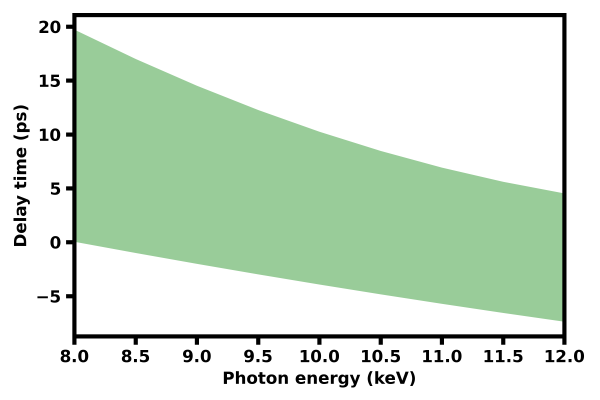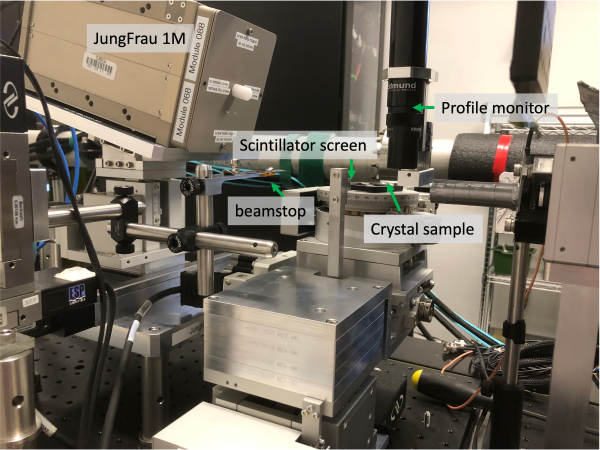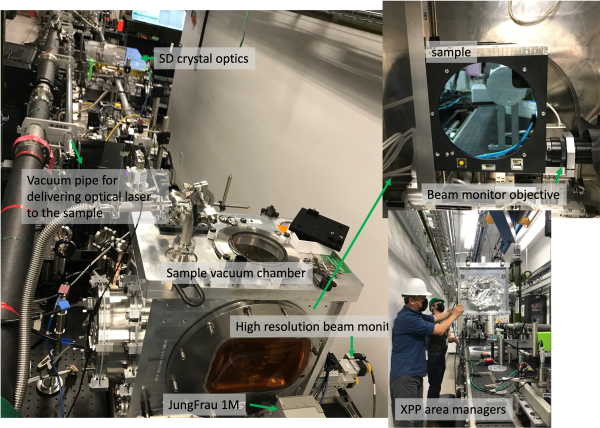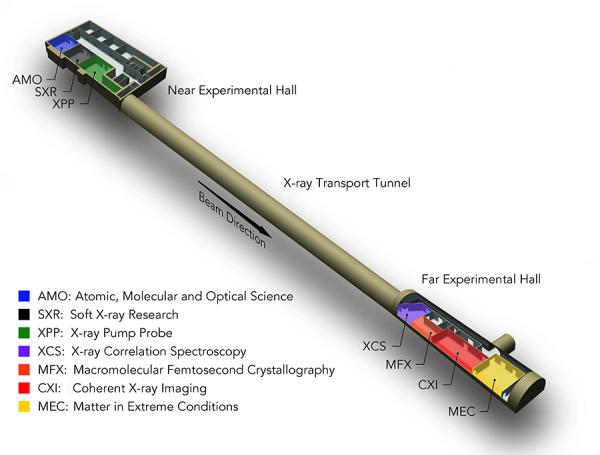XPP Standard Configurations
XPP is not available in Run 25
XPP Standard Configuration #1 for Run 23
Types of Experiments
With this standard configuration, XPP will be able to support ambient pressure time-resolved pump-probe hard X-ray diffraction measurements on various condensed matter systems in the form of crystals, alloys, and thin films, etc.
X-ray and X-ray Focus
X-ray energy will be fixed between 9-13 keV by the large offset monochromator using the diamond (111) configuration. We expect an average photon flux of 1010/pulse after the monochromator. Narrow bandwidth option is avaliable by using Si(333), Si(440), Si(444), Si(660), or Si(555) channelcut crystal monochromator. Only 1D focus is avaliable for the narrow bandwidth option in Run 22 for the standard configuration.
The default polarization is vertical. Horizontal and circular polarizations and switching capability with the phase retarder are available. Compound refractive lenses will be available to deliver a beam size ranging from 10 to 300 μm at the sample. 1D focusing is available as well.
Optical Pump Lasers
Time-resolved experiments employing tunable femtosecond pulses will be supported under this standard configuration. In addition to the 800/400 nm 50 fs Ti:Sapphire fundamental/2nd harmonic wavelengths, an OPA will be available to cover the wavelength range of 480-2400 nm. THz excitation based on optical rectification in LiNO3 is also available in this standard configuration, providing peak field strength beyond 500kV/cm. The pump beam will be propagating collinearly with the X-ray beam. A small crossing angle up to 7 degrees can be accommodated for most wavelengths too. We note that the efficiency of the optics and the performance of the laser and the OPA will not be the same for the entire wavelength range. The achievable peak intensity/fluence will be determined by the existing optical system and will not be modified. Contact the XPP scientists to discuss specific laser parameters and to confirm whether they can be achieved in this standard configuration of the laser.
Timing Diagnostics
The spectral-encoding based timing tool will be available to provide shot-to-shot jitter measurement. We expect a time resolution of 100 fs considering the pump/probe pulse duration as well as the jitter correction accuracy.
Sample Manipulation and Temperature Control
For Run23, XPP will provide a new 4-circle diffractometer instead of the Huber Kappa diffractometer because of removing the XPP goniometer. By using the new diffractometer, the users can have more flexiblities and simpler operations for sample alignment.
The Oxford cryostream system will be available to provide in-air sample cooling down to 120 K. Heating up to 400 K can be delivered by the same system as well.
Every user group accepted and scheduled to use the XPP standard configuration will be required to know the crystallographic orientation of their sample.
Detectors
An epix10K or Jungfrau1M detector will be mounted on the XPP detector robot arm for measuring the diffracted X-rays. The detector can be positioned to cover most of the upper reciprocal hemisphere. Typical sample-detector distance ranges from 100-1000 mm. In addition, Diodes will be available to measure high intensity diffraction peaks that are beyond the dynamic range and damage threshold of the pixelated detectors.
XPP Instrument Staff
Takahiro Sato, Zach Porter, Hasan Yavas, Matthieu Chollet
Parameter Table
To be considered for scheduling in this standard configuration, users will be required to include a table in the proposal that lists the specific experimental parameters to ensure compatibility with these configurations. If the experimental parameters are not compatible with the standard configuration or if the table of parameters is incomplete, the proposal will be reviewed and considered for scheduling as general user proposal. Please see the table of required parameters. No fundamental changes to the standard configurations will occur, but some details of the configuration may be updated in response to inquiries, so users should recheck the website before submitting your proposal to confirm that you have the latest information. Address any questions to the instrument staff.
XPP is not available in Run 24
XPP Standard Configuration #2 for Run 23
Types of Experiments
With this standard configuration, XPP will be able to support time-resolved pump-probe hard x-ray forward small and wide angle scattering (SAXS & WAXS) from solid samples.
X-ray and X-ray Focus
Available X-ray photon energy ranges from 9-18 keV when pink beam is requested. For monochromatic, photon energy shall be ~10keV. We expect an average photon flux of 1012/pulse for pink mode and 1010/pulse if operating with the diamond (111) multiplexing monochromator. Refractive Be lens will be available to deliver a beam size ranging from 10 to 200 um at the sample. 1D focusing is available as well.
Optical Pump Lasers
Time-resolved experiments employing tunable femtosecond pulses will be supported under this standard configuration. In addition to the 800/400 nm 50 fs Ti:Sapphire fundamental/2nd harmonic wavelengths, an OPA will be available to cover the wavelength range of 480-2400 nm. The optical pump beam will be propagating collinearly with the x-ray beam with about 2 degree crossing angle. We note that the efficiency of the optics and the performance of the laser and the OPA will not be the same for the entire wavelength range. The achievable peak intensity/fluence will be determined by the existing optical system and will not be modified. Contact the XPP scientists to discuss specific needs and to confirm whether they can be achieved in this standard configuration of the laser.
Timing Diagnostics
The spectral-encoding based timing tool will be available to provide shot-to-shot jitter measurement. We expect a time resolution of 100 fs considering the pump/probe pulse duration as well as the jitter correction accuracy.
Sample Manipulation and Temperature Control
A vacuum chamber with translation stages will be available. Angular alignment of the sample will be limited to 1 rotation axis covering up to 120 degrees.
Detectors
An ePix10k 2.1Mpixel detector will be mounte on the XPP robotic detector positioner for WAXS, and downstream on detector positioning stages at distances up to 10 meters for SAXS.
XPP Instrument Staff
Matthieu Chollet, Matthias Hoffmann, Takahiro Sato, Matt Seaberg, Sanghoon Song, Yanwen Sun, Diling Zhu.
Parameter Table
To be considered for scheduling in this standard configuration, users will be required to include a table in the proposal that lists the specific experimental parameters to ensure compatibility with these configurations. If the experimental parameters are not compatible with the standard configuration or if the table of parameters is incomplete, the proposal will be reviewed and considered for scheduling as general user proposal. Please see the table of required parameters. No fundamental changes to the standard configurations will occur, but some details of the configuration may be updated in response to inquiries, so users should recheck the website before submitting your proposal to confirm that you have the latest information. Address any questions to the instrument staff.
XPP is not available in Run 24
XPP Standard Configuration #3 for Run 23
Types of Experiments
With this standard configuration, XPP will provide "X-ray pump and X-ray probe" type experiments by using Mini Split&Delay optics consisting of all channel cut based crystals for the stability. The compact split-delay optics at XPP generate double x-ray pulses with tunable picosecond delays in between. The two pulses in rapid succession can then be utilized to perform x-ray pump x-ray probe or x-ray probe-probe, i.e., split-pulse x-ray photon correlation spectroscopy (XPCS) measurements. Additionally, an optical laser beam can be delivered to the sample to realize pump-probe-probe. Details regarding the design and performance of the system can be found in the following two papers:
- Li, H., Sun, Y., Sutton, M., Fuoss, P., & Zhu, D. (2020). Design of an amplitude-splitting hard x-ray delay line with subnanoradian stability. Optics letters, 45(7), 2086-2089.
- Li, H., Sun, Y., Vila-Comamala, J., Sato, T., Song, S., Sun, P., ... & Zhu, D. (2021). Generation of highly mutually coherent hard-x-ray pulse pairs with an amplitude-splitting delay line. Physical Review Research, 3(4), 043050.
Time delay between the double X-ray pulses
The system features a continuous delay scan capability with the available time delay denoted in green shade plotted below:

Sample manipulation and sample plane diagnostics
6-axis sample plane motions are available. Samples can be solid, liquids and gas.
They are all customized based on experimental needs. The only constraint is the beam height equal to 254 mm from the platform i.e., strongback 5 of XPP.
Examples of sample manipulation is shown as below, we note that the XPP team can customize many components to optimize the experiment:
- Platform for crystal samples (available with many more motion axis upon request)

- XPP vacuum chamber (available upon request)

- For more configurations not included as the standard configuration, Liquid jet with helium enclosure and in-vacuum high temperature cell can be provided. For more details, please contact Yanwen Sun.
X-ray and X-ray Focus
X-ray energy will be fixed between 8-10 keV by the large offset monochromator using the diamond (111) configuration. We expect an average photon flux of 1010/pulse after the monochromator. Due to the finite size of the current grating used in the split-delay system, unfocused beam needs to be slit down to 300 micron.
Beam focusing can be performed with Beryllium compound refractive lenses to a close-to diffraction limited spot, e.g., 1.8 micron FWHM with the typical 1.5 meter focusing length @ 9.5 keV. For pump probe measurement, the beam size on the sample can be changed by moving the sample with respect to the focal position. For XPCS measurements, we suggest that the sample should stay at focus. Lenses can also be changed during the beamtime.
Bandwidth and throughput
The bandwidths of the individual branches, i.e., fix-delay, delayed branches are 0.53 eV and 0.40 eV at 10 keV.
For wide-angle XPCS measurements sensitive to the mutual longitudinal coherence of the beam, a Si(311) double channelcut mono can be used upstream of the system to further confine the bandwidth, i.e., 0.3 eV for both branches at 10 keV.
With the monochromatic beam from the large offset monochromator containing the two diamond (111) crystals as input, the throughput at the sample plane is 3%.
Detectors and scattering geometry
X-ray pump X-ray probe
A JungFrau-1M detector can be placed at customized distances and angles with respect to the sample.
Split-pulse XPCS
- Four ePix100 assembled in a 2 by 2 array can be placed at a tunable distance from 0.5-1.5 meter in the horizontal scattering geometry up to 30 degree scattering angles. A fixed longer detector arm, i.e, 2.5 meter is available at the vertical scattering geometry with a scattering angle tunable from 0 to 30 degrees.
- One small-angle ePix100 detector will be placed 5 meter downstream the sample to allow constant monitoring of spatial overlap through speckle correlation.
- A JungFrau 1M detector is also available to simultaneously record the structure factor of the samples.
- Vacuum drift pipes with different lengths and beamstops both near the sample and the detectors are available for optimizing signal to background.
Detectors
An ePix10k 2 megapixel detector or a Jungfrau 1 megapixel detector will be mounted on the robotic detector positioned and be available for the measurement.
XPP Instrument Staff
Yanwen Sun, Sanghoon Song, Takahiro Sato, Diling Zhu
XPP CONTACTs
Takahiro Sato
XPP Instrument Lead
(650) 926-3749
takahiro@slac.stanford.edu
Adam White
Area Manager
(650) 926-4778
adamwh@slac.stanford.edu
Roberto Alonso-Mori
Spectroscopy Scientist
(650) 926-4179
robertoa@slac.stanford.edu
Diling Zhu
Methologist/X-ray Optics Scientist
(650) 926-2913
dlzhu@slac.stanford.edu
Matthieu Chollet
Staff Scientist
(650) 926-3458
mchollet@slac.stanford.edu
Sanghoon Song
Staff Scientist
(650) 926-2255
sanghoon@slac.stanford.edu
Yanwen Sun
XPCS/X-ray Optics Scientist
(650) 926-2562
yanwen@slac.stanford.edu
Hasan Yavas
IXS /RIXS Scientist
(650) 926-3084
yavas@slac.stanford.edu
Matthias Hoffmann
Laser Scientist
(650) 926-4446
hoffmann@slac.stanford.edu
Ying Chen
Mechanical Engineer
yingchen@slac.stanford.edu
Vincent Esposito
Controls & DAQ Engineer
(650) 926-3410
espov@slac.stanford.edu
XPP Control Room
(650) 926-1703
XPP Hutch
(650) 926-7463


